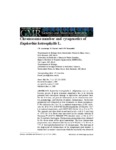Use este identificador para citar ou linkar para este item:
http://www.alice.cnptia.embrapa.br/alice/handle/doc/491644Registro completo de metadados
| Campo DC | Valor | Idioma |
|---|---|---|
| dc.contributor.author | AARESTRUP, J. R. | pt_BR |
| dc.contributor.author | KARAM, D. | pt_BR |
| dc.contributor.author | FERNANDES, G. W. | pt_BR |
| dc.date.accessioned | 2011-04-10T11:11:11Z | pt_BR |
| dc.date.available | 2011-04-10T11:11:11Z | pt_BR |
| dc.date.created | 2009-01-12 | pt_BR |
| dc.date.issued | 2008 | pt_BR |
| dc.identifier.citation | Genetics and Molecular Research, Ribeirão Preto, v. 7, n. 1, p. 217-222, 2008. | pt_BR |
| dc.identifier.uri | http://www.alice.cnptia.embrapa.br/alice/handle/doc/491644 | pt_BR |
| dc.description | Euphorbia heterophylla L. (Euphorbiaceae) is a herbaceous species of great economic importance due to its invasive potential and consequent damage to agriculture and pasture land. For the first time, we provide information on its chromosome nwnber, morphology, and behavior of mitotic chromosomes. Seeds were germinated and submitted to four treatments to obtain metaphases: 0.5% co1chicine for 2 to 5 h, at ambient temperature; 0.5% co1chicine for 16 to 24 h; 0.0029 M 8-hydroxyquinoline (8-HQ) for 2 to 5 h at ambient temperature, and 0.0029 M 8-HQ for 16 to 24 h at 4 degrees C. The material was then fixed in methanol: acetic acid (3: I) and kept at -20 degrees C for 24 h. Roots were macerated in the enzyme solution ofFlaxzyme (TM) (NOVO FERMENT T)-distilled water (I: 40) at 34 degrees C for 2 h and later fixed again. Chromosome preparations were obtained by the dissociation of the apical meristems. The best chromosome preparations were obtained with the use of 8-HQ for 21 h 30 min at 4 degrees C. E. heterophylla showed 2n = 28 chromosomes. The short arm of the largest pair of chromosomes of the complement (pair nwnber 1) displayed a secondary constriction while the nuc1eolus was observed in the interphasic cell. Structural rearrangements were also observed in the E. heterophylla L. genome. The genomic instability associated with polyploidy may be the result of selection shaped by environmental adaptations and/or human-induced manipulation through agricultural practices. | pt_BR |
| dc.language.iso | eng | eng |
| dc.rights | openAccess | eng |
| dc.subject | Planta daninha | pt_BR |
| dc.title | Chromosome number and cytogenetics of Euphorbia heterophylla L. | pt_BR |
| dc.type | Artigo de periódico | pt_BR |
| dc.date.updated | 2018-05-24T11:11:11Z | pt_BR |
| dc.subject.nalthesaurus | evolution | pt_BR |
| dc.subject.nalthesaurus | polyploidy | pt_BR |
| riaa.ainfo.id | 491644 | pt_BR |
| riaa.ainfo.lastupdate | 2018-05-24 -03:00:00 | pt_BR |
| dc.contributor.institution | Juliana Roriz Aarestrup, Bolsista da FAPEMIG; DECIO KARAM, CNPMS; Geraldo W. Fernandes, UFMG. | pt_BR |
| Aparece nas coleções: | Artigo em periódico indexado (CNPMS)  | |
Arquivos associados a este item:
| Arquivo | Descrição | Tamanho | Formato | |
|---|---|---|---|---|
| Chromossomenumber.pdf | 963.93 kB | Adobe PDF |  Visualizar/Abrir |









